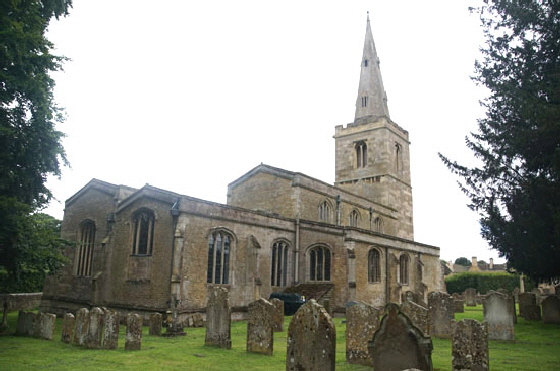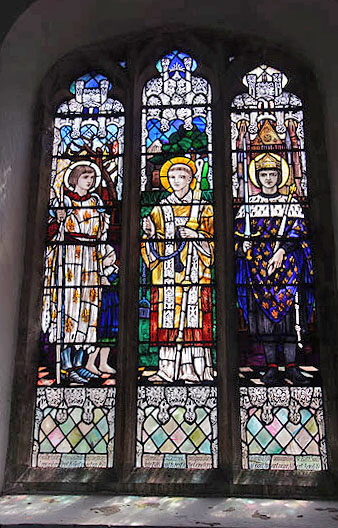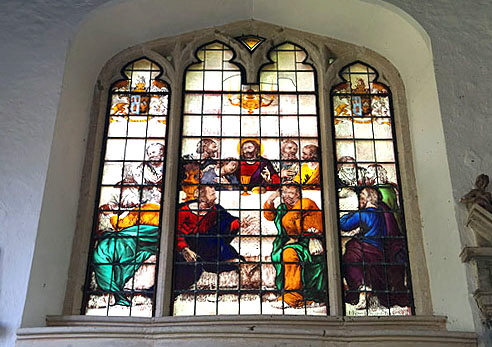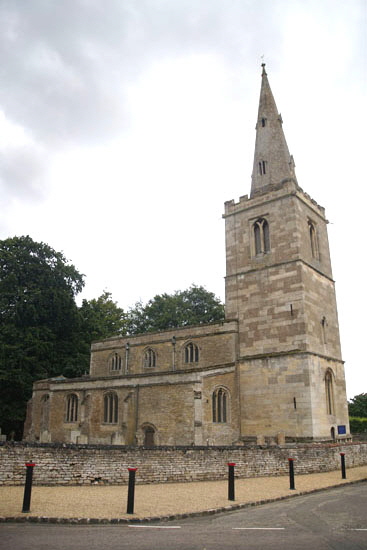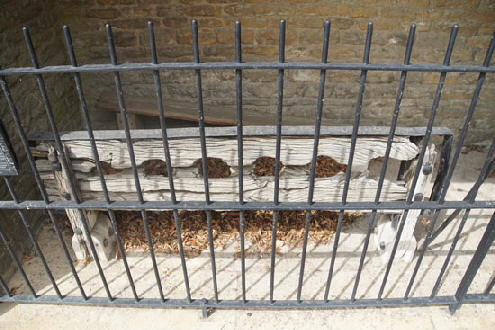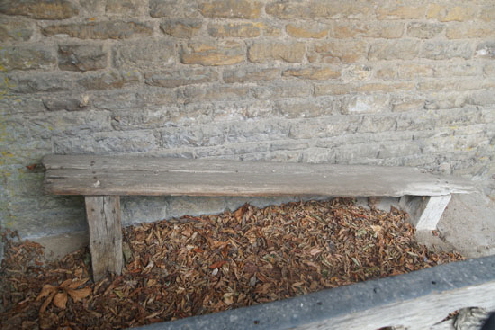|
Alphabetical List |
|
|
|
|
|
|
|
County List and Topics |
|
|
|
Please sign my Guestbook and leave feedback |
|
|
||||||||||||||||||||||
|
There was also a crypt underneath the Mildmay tomb that housed the tombs of Fane family, the Earls of Westmorland. A bizarre thing for a fifteenth century parish church to have, you might think. It was sealed in 1900. |
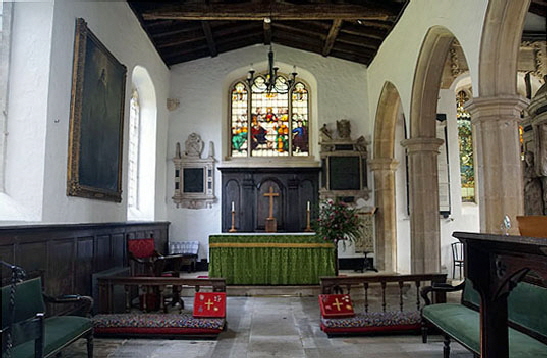 |
||||||||||||||
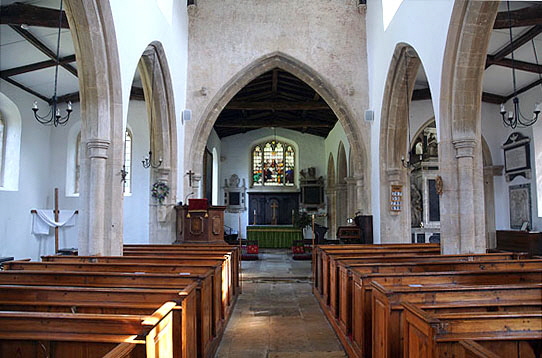 |
||||||||||||||
|
Left: The view to the east. There are aisles to north and south. The chancel arch fills the whole width of the nave and gives an unobstructed view to the east end. Right: The chancel. The window is of 1732, a very rare vintage indeed. To the right you can see the lofty three arch arcade that leads to the Mildmay tomb in the south chapel. |
||||||||||||||
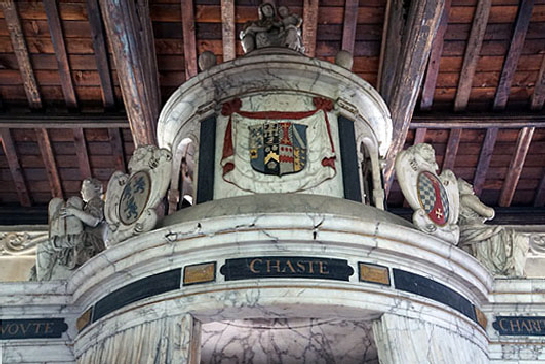 |
||||||||||||||
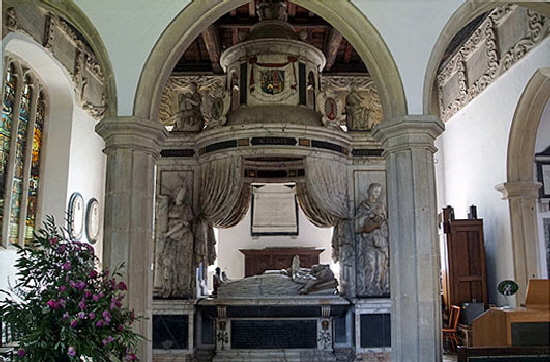 |
||||||||||||||
|
Left: The Mildmay tomb. It has been described thus: the Mildmay monument is one of the largest and most theatrical of its type in the country”. The Mildmays were occupants of Apethorpe Hall which was at one time owned by Elizabeth I and which is almost next to the church. To modern eyes - including my own - it seems very odd that a man and his wife could dominate a church in this way for perpetuity. Sir Anthony (unlike his father) had no great claim to fame. He was England’s ambassador to Paris during the later period of Queen Elizabeth I’s reign and was MP for a number of English constituencies. His contemporary portrait (below) shows him to be something of a gay blade. Right: The detail on the top of the monument (there must be an “official” term for that, surely?) shows extraordinary richness of the edifice. The four cardinal virtues are represented by female figures at each corner. The monument also adds the words “Chaste” (seen here) and “Valiant” which are not cardinal virtues. I’m glad to see chastity is not so highly rated! |
||||||||||||||
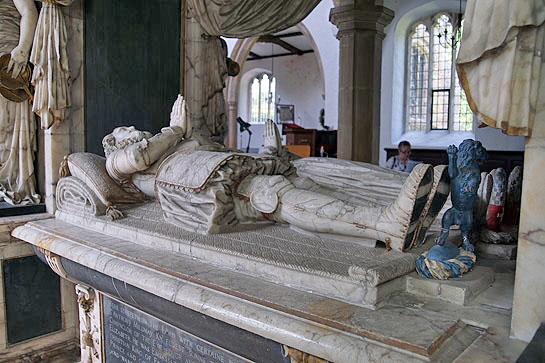 |
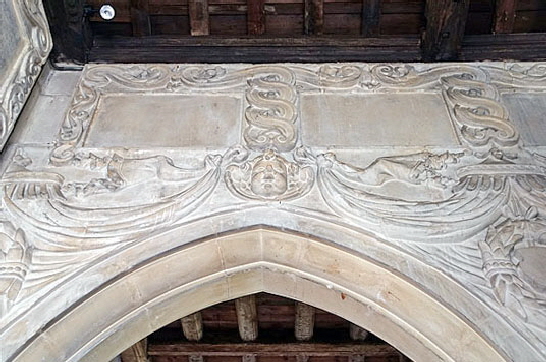 |
|||||||||||||
|
Left: Sir Anthony and the missus - Lady Grace - lie in state. He is wearing “Greenwich Armour”. Right: The highly unusual stone facade within the south chapel leave you in no doubt that it was built entirely to house the tomb. |
||||||||||||||
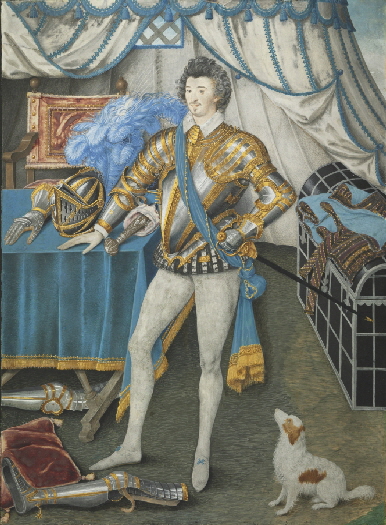 |
||||||||||||||
 |
 |
|||||||||||||
|
Left: the west side of the monument. Centre: This “virtue” is Prudence traditionally represented by book, scroll and (in this case) mirror. The serpent in her left hand represents an attack on this virtue. Right: Sir Anthony as painted by the court painter Nicholas Hilliard. It’s an odd representation. He is either putting on or removing his armour. I think he just wanted Hilliard to show his nice long legs. You would have thought that his sword would have been last on or first off but doubtless he also wanted to show his martial instincts in his portrait. My goodness, what a young coxcomb! |
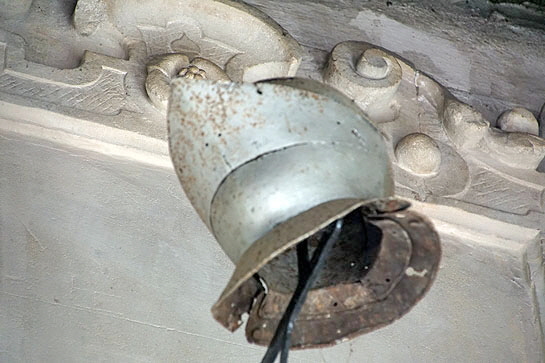 |
|||
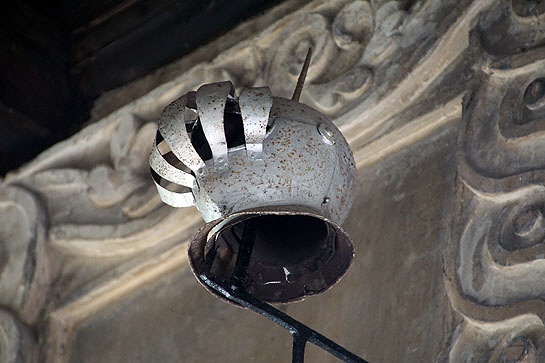 |
|||
|
On the same theme of Sir Anthony’s apparent vanity, we are also treated to these two very interesting helms mounted near the ceiling. Whether our Tony ever chanced his arm in any kind of battle I haven’t been able to ascertain. I have my suspicions! |
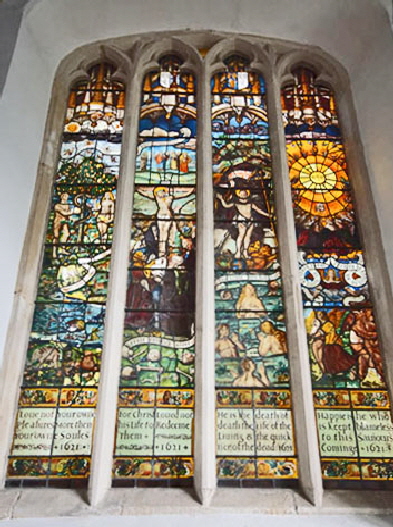 |
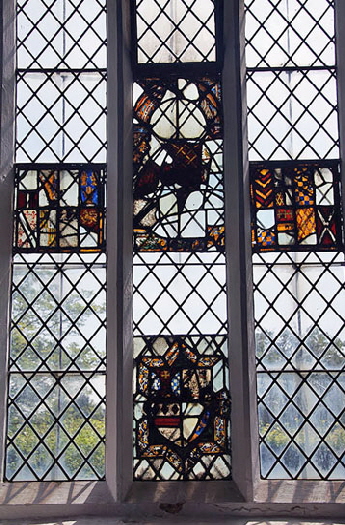 |
||||
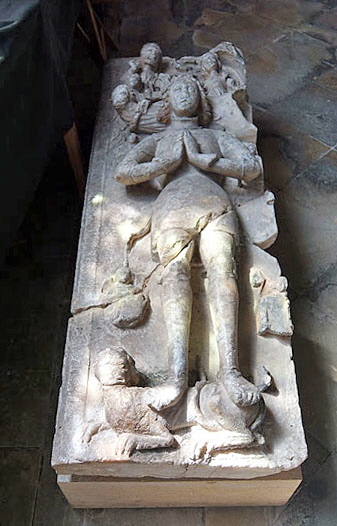 |
|||||
|
Left: An altogether more modest tomb slab of Sir Richard Dalton 1363-1442. It is half life-size. Behind his head is a scene of the Annunciation. Centre: The stained glass of 1621. It looks surprisingly modern. Look, for example, at the vibrant orange circle in the rightmost panel which, as a whole, represents Christ surrounded by his patriarchs and angels. It is a work of art rather than an example of the soulless stilted representations of most Victorian glass. Right: More seventeenth century glass showing the arms of various great families. These were to portray the lineage of Sir Francis Fane 1580-1629 who became the first Earl of Westmorland. Sir Francis, the son-in-law of Sir Anthony, actually commissioned the Mildmay monument according to his will. In this glass you see in various configurations the arms of Mildmay, Fane, Sherington and Despenser. Despenser is an ancient family and Hugh Despenser was the favourite of Edward II. His unpopularity was such that the baronial rebellion against Edward was known as the “Despenser War”. Hugh’s death in Hereford at the hands of Queen Isabella and Roger Mortimer was particularly gruesome. Before the normal horrors of hanging, drawing and quartering began Despenser had biblical tracts carved into his skin and he was given a crown of nettles. After his half-hanged body had been lowered from its fifty foot scaffold his penis and testicles were cut off. That was before the usual rituals of having being disembowelled and having his beating heart removed. Sorry to spoil your lunch! |
|
|
||||||||||||||||
|
Left: This is early twentieth century glass commemorating the death of Lt Colonel Harold Brassey, killed in action in 1916. They were then owners of Apethorpe Hall. Note how stilted and formal the composition is. The heads of the three figures are like sepia photographs. Compare this window with the seventeenth and eighteenth century examples on this page |
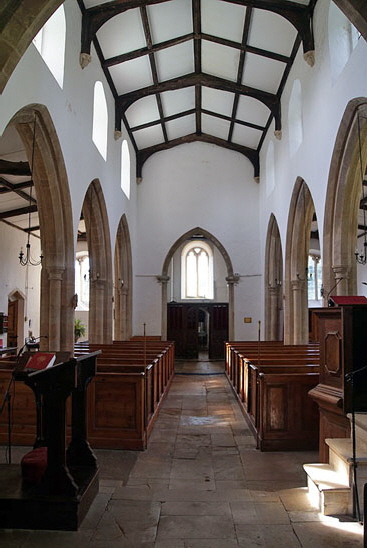 |
 |
 |
|||
|
Left: The view to the west end. Centre: Another rarity: Apethorpe’s eighteenth century font. The bowl is marble and the stem alabaster. I’m assuming the pretty floral arrangement is inside a removable pot! It’s interesting to reflect on the way this font has evolved from the hefty tubs of the Romanesque period and the decorative but still large octagonal fonts of the pre-Reformation period. Art and fashion seem to have overtaken functionality - a very eighteenth century thing. Right: The south porch. |
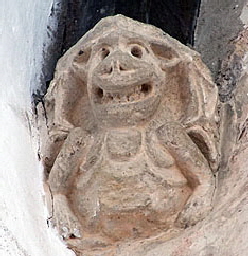 |
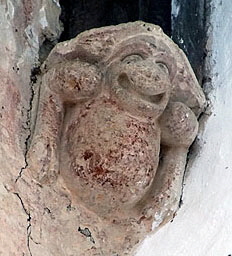 |
|||||||||||||||||
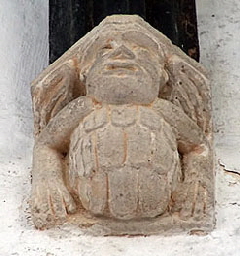 |
||||||||||||||||||
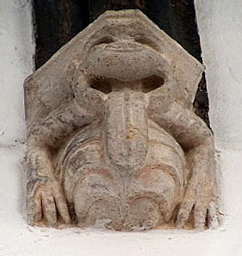 |
||||||||||||||||||
|
These cheerful-looking grotesques adorn the roof corbels in the nave |
||||||||||||||||||
 |
||||||||||||||||||
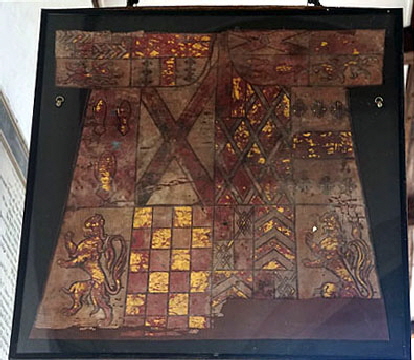 |
||||||||||||||||||
|
Left: The south aisle with the Mildmay Chapel beyond it. Right: The tabard of Sir Anthony Mildmay hangs in the south aisle near the chapel. |
||||||||||||||||||
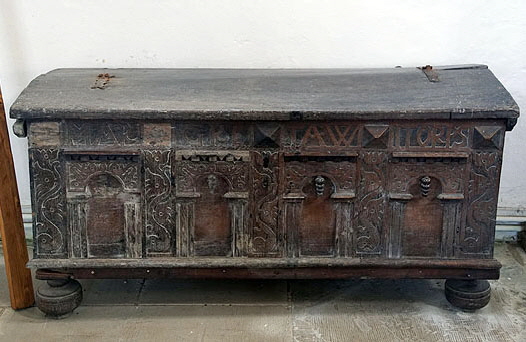 |
||||||||||||||||||
 |
||||||||||||||||||
|
Left: Another hanging display. This one is labelled as material from the “bishop’s chair”. I can’t find out which bishop. It is late sixteenth/early seventeenth century. Right: A wonderful wooden cope chest in the north aisle. Again, I can find nothing written about its provenance. |
|
|
||||||||||||||||||||||||||||||||||||||||
|
Footnote 1 - Sir Walter Mildmay |
|
Sir Walter’s story is altogether more interesting than that of his poseur son. He was the son of Thomas Mildmay who served Henry VIII as Auditor of the Court of Augmentations. The function of this court was to administer the landsand property seized from the Roman Catholic Church at the Dissolution of the Monasteries. As auditor Thomas would have been responsible for valuing this land so it could be sold. The scope for corruption must have been vast and it is no surprise to know that Thomas amassed a great fortune. |
|
Footnote 2 - Apethorpe Hall |
|
The fifteenth century hall was willed to Elizabeth I from her father, Henry VIII. Edward VI, however, was Henry’s successor and he granted it to Sir Walter Mildmay in exchange for property elsewhere. Elizabeth is known to have dined there in 1562 and 1566. Sir Anthony inherited it from Walter who in turn left it to his daughter who had married Sir Francis Fane, later Earl of Westmorland. The Fanes held it for three hundred years. Both James I and Charles I were enamoured of it. English Heritage say: “James I so loved Apethorpe that he personally contributed to its extension to make it more suitable for his 'princely recreation' and 'commodious entertainment', particularly for hunting in the nearby royal forest of Rockingham. The resulting series of state rooms, including the King's Bedchamber and the impressive Long Gallery, is one of the most complete to survive from the Jacobean period”€¯ In 1622 King James I gave Fane 100 oak trees and permission to buy 100 more 'at reasonable rates' to enlarge Apethorpe 'for the more commodious entertainment of his majesty.' Thus, Apethorpe Hall reached its zenith. Charles I also stayed there regularly. The Hall was acquired by the Brassey family (still resident in the area) in 1904 when the Westmorlands fell on hard times. After World War II, the hall and grounds were the site of an “approved school” (non UK readers or UK readers of a more recent vintage should be aware this was a school for young criminals and delinquents) run by the Roman Catholic Church. The hall eventually became the property of Wanis Mohammed Burweila, but he left the country after the Libyan Embassy siege in 1984. Sensible chap. Libyans weren’t too popular in the UK at that time. I continue the story from 2004 when the Government acquired it, having allegedly ridden roughshod over one Simon Karimzadeh, a Libyan businessman who fondly imagined he had already bought it! I quote from the Daily Telegraph of 24 September 2004: “The saga of Apethorpe Hall, a Grade I listed country house in Northamptonshire, and how it was snatched from under Mr Karimzadeh's nose by a compulsory purchase order, is convoluted by any standards. Dickens would have made a novel out of it. Trollope would have made three novels out of it. The cast list includes mystery Libyans, the president of Queens Park Rangers football club and Tessa Jowell, the Culture Secretary - and that is before m'learned friends are taken into account. Having acquired it for £3.5 million, English Heritage proceeded to spend £8 million restoring it and then in 2008 put it on the market at a price of £4.5 million. Fabulous economics, eh? After all it had only 51,000 sq ft hall, complete with stable block, gardener's cottage and 45 acres of land€¯ so really it was a c**p property, wasn’t it?. It remained on the market until it was bought for £2.5m by French professor, diplomat and academic, Jean Christophe Iseux, Baron von Pfetten. You might be interested to read about the real Jean Claude on Wikipaedia here. What a great piece of business for the country, though. Why, you could acquire a three-bedroomed penthouse apartment in London for that price. There was a sting in the tail though. Oh, yes. You see, the Baron has to open it to the public for - wait for it - .fifty days a year. Phew. What a sacrifice for the poor old Baron. Really, he wuz robbed, wasn’t he?! I long for an announcement that a French chateau on the Loire has been sold for a couple of million Euros to a British professor, diplomat and academic€¯. In the interests of fairness, even after the English Heritage intervention the Hall still lacked some basic facilities and is alleged to still require millions more investment€¯ before it can become a family home€¯. Sorry, but I have to giggle at that last bit! It is now rebranded€¯ as Apethorpe Palace due to its status as a former B&B that got great Royal Trip Advisor reviews. That’s nice for Jean Christophe, I’m sure. Just don’t call it “Palace” when you are in Apethorpe though. The locals who at the time of writing have just seen their local pub close might put you in the old stocks. They seem to have this strange idea that their heritage has been sold for the proverbial mess of potage. |
 |
|||||
|
£2.5m doesn’t get you a lot in England these days does it? |
|||||
|
|
|||||
